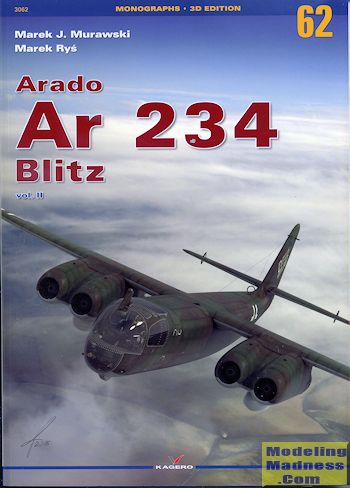Kagero's Arado Ar-234 Blitz Vol 2
 The Arado
Ar-234 series of aircraft was able to garner a few aviation firsts. It was the
first purposely designed and operated jet bomber and it was the first four
engine jet to fly. The Arado company was pretty much state owned, unlike others
such as Heinkel and Dornier. As such, they did not have to deal with a board of
directors nor any stock holders. This allowed them somewhat more freedom.
The Arado
Ar-234 series of aircraft was able to garner a few aviation firsts. It was the
first purposely designed and operated jet bomber and it was the first four
engine jet to fly. The Arado company was pretty much state owned, unlike others
such as Heinkel and Dornier. As such, they did not have to deal with a board of
directors nor any stock holders. This allowed them somewhat more freedom.
Arado was well known for a series of
successful trainer aircraft as well as their Ar-196 float plane. They also built
the designs of other companies as part of the war effort so it was not a small
concern. They were tasked with building a jet powered bomber. The head designer
had no real interest in the subject so foisted it off on another. After the
usual design and development work, the first prototype was ready to go in 1943.
In order to save weight that the rather anemically powered jet engines were to
carry, it was designed to be operated from a take off trolley, landing on skids
beneath the fuselage and under each engine nacelle.
This method operated well on the ground,
but using it caused other issues. Initially it was to be released at about 1,000
feet and fall back on a parachute. Many were destroyed and so the height was
lowered. Even at low altitude, most dollies did not survive their initial use.
Eventually, the aircraft released the dolly while it was still on the ground.
This worked, but it was not the answer. The answer was a later design that
sacrificed one of the fuselage fuel tanks for landing gear. The aircraft was
lengthened and widened to allow this and is the version of which most of us are
familiar.
Engines on early jets were a real issue.
The aircraft was designed around the BMW 003, but these engines were notoriously
unreliable and so most aircraft were powered by Junkers 004. Eventually the BMW
plant got a big influx of funds and this allowed reliability of its engines to
dramatically increase. All the production four engine Ar-234Cs were powered by
these. However, most of the war missions were flown by Ar-234Bs and their two
Jumo 004s.
This is Kagero's second volume on this
aircraft and one of their 3D productions.
That pretty much means that half the book will be a myriad of superbly done CAD drawings
of various parts of the aircraft. This edition provides what was not covered in
volume 1 and also gives us a number of overall images. This includes the four
engine 234C-3, of which several were delivered to KG 76, but never used
operationally.
The first quarter of the book covers the
operational use of the aircraft with its intended units, the bomber and recce
squadrons. The recce units were the only ones to briefly use the prototypes with
their skid landing gear and they were pleased to get the ones with the wider
fuselage and more normal gear. These units were quite successful as they flew at
speeds that made them virtually immune. The other uses were the bomber units.
This basically means KG 76. I was actually quite surprised to read that these
planes performed a lot more missions that I'd thought. Their success was
minimized as much by the low numbers of planes in each raid as it was by the
heavy defense. The next section, before the 3D images consists of sections from
the tech manual that covers the various systems. Kagero is known for its plans
and in this volume, we get plans for the four engine 234C-3 in 1/72, 1/48 and
1/32. The larger two scales are provided in additional large fold outs slipped
into the book.
I know that some might wonder why all the
historical bits and plans could not have been included into a single volume
without the 3D artwork. It could have easily been done, but then Kagero's more
recent marketing has relied on the 3D aspect of these publications and I don't
see this changing in the near future. Regardless of how you feel about this
feature, it is a well done book that is interesting and will be quite useful to
enthusiasts and modelers alike.
October 2015
My thanks to Casemate Publishing for the review sample. Visit them at
Casemate Publishing and order yours, or get them at
your favorite hobbyist.
If you would like your product reviewed fairly and
fairly quickly, please contact
me or see other details in the
Note to
Contributors.
 The Arado
Ar-234 series of aircraft was able to garner a few aviation firsts. It was the
first purposely designed and operated jet bomber and it was the first four
engine jet to fly. The Arado company was pretty much state owned, unlike others
such as Heinkel and Dornier. As such, they did not have to deal with a board of
directors nor any stock holders. This allowed them somewhat more freedom.
The Arado
Ar-234 series of aircraft was able to garner a few aviation firsts. It was the
first purposely designed and operated jet bomber and it was the first four
engine jet to fly. The Arado company was pretty much state owned, unlike others
such as Heinkel and Dornier. As such, they did not have to deal with a board of
directors nor any stock holders. This allowed them somewhat more freedom.